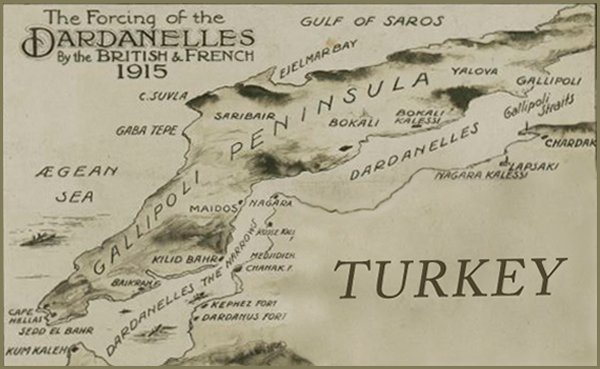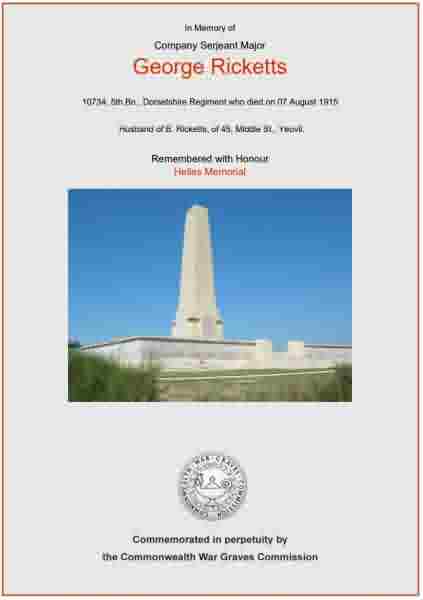yeovil at War
George Ricketts
Killed in action during the Gallipoli Campaign
George Ricketts was born in Yeovil in the autumn of 1874. He was the son of wheelwright James Ricketts (1843-1922) and Emily née Symes (1843-1924). In the 1891 census James and Emily with five of their children were living in Vicarage Street, close to the junction with Middle Street. At this time 15-year old George was working as a labourer.
 George
became a
professional
soldier,
enlisting on 14
March 1892,
giving his age
as 18 years 7
months and gave
his occupation
as a carpenter.
He joined the
1st Battalion,
Dorsetshire
Regiment with
the Service
Number 3410.
According to his
attestation
papers, he had
previously
served with the
3rd Battalion,
Somerset Light
Infantry, but
had purchased a
discharge.
George
became a
professional
soldier,
enlisting on 14
March 1892,
giving his age
as 18 years 7
months and gave
his occupation
as a carpenter.
He joined the
1st Battalion,
Dorsetshire
Regiment with
the Service
Number 3410.
According to his
attestation
papers, he had
previously
served with the
3rd Battalion,
Somerset Light
Infantry, but
had purchased a
discharge.
From his (partly destroyed) attestation papers we know that George was 5' 4¾" tall, weighed 134 pounds and had a chest measurement of 35". He had brown eyes and light brown hair.
The Regiment, including George, served in India on the North West Frontier fighting during the Tirah Expedition (1897-1898) in order to regain control of the Khyber pass from the Afridi tribe. George was awarded the India Medal with two Clasps – Tirah 1897-98 and Punjab Frontier 1897-98 in 1898, shown at left.
George was appointed Lance Corporal on 23 October 1896, to Corporal on 5 July 1898 and to Lance Sergeant on 20 January 1901. On 10 October 1901 he extended his service to complete 17 years with the Colours.
He extended again on 18 October 1902 in order to complete 21 years service. He was promoted to Sergeant on 3 July 1908 and posted on 1 October 1910, being awarded the Long Service Medal and the Good Conduct Medal. By the time of the 1911 census 38-year old George was stationed at Alma Barracks, Blackdown, Farnborough, Hampshire. He was promoted to Colour Sergeant on 28 February 1911. George was finally discharged on 13 March 1913, having served 20 years, 11 months, 27 days.
After completing his service, George was placed on the Reserve List. In the summer of 1914 George married Bessie Hoare (1884-1955) at Yeovil. They lived at 45 Middle Street.
At the outbreak of war in 1914 George was recalled to his regiment, joining the 5th (Service) Battalion. His new Service Number was 10734. He was recalled as a Private on 4 September 1914, but promoted to Colour Sergeant the same day. Just four days later, on 8 September 1914, he was promoted to Company Sergeant Major. He was now 40 years old. He was granted the rank of Warrant Officer, Grade II, on 29 January 1915.
The 5th Battalion, Dorsetshire Regiment, had been raised in Dorchester in August 1914. Formed entirely of Kitchener Volunteers from the county, the 5th Battalion left England on 3 July 1915 aboard the 'Aquitania', as a part of the 11th Division, sailing to Lemnos. Here they became acclimatised to the conditions by digging wells for the growing force and making roads. However, a virulent stomach bug laid many low and was a portent of things to come in the Suvla trenches.
The 5th Dorsets were to land at Suvla Bay, Gallipoli Peninsula, on 6/7 August 1915, under cover of a moonless night, as 34th Brigade's second wave. However, the plan miscarried when the leading landing craft headed too far south and ran aground shoals. With Turkish troops alerted, the delays and the inexperienced British Brigades unable to find their objective at Hill 10 in the pitch black, there was paralysis. The Dorsets later commented on the performance of their Brigade Headquarters "From the first things that had gone wrong, the misfortune which had attended the landing.... and had led to.... everything being thrown out of gear; where resolute handling and vigour were urgently needed, resolution and initiative had been conspicuously lacking."
It wasn't until dawn on 7 August 1915 that the 5th Dorsets landed and the Battalion headed north to mount a flanking attack on Hill 10 that was now only too obvious from the flashes of Turkish gunfire. 'A' Company gave covering fire from the dunes, while the remainder of the Battalion pressed forward up the gentle slopes of the hill in short well rehearsed rushes. The Turkish battalion fled and at 0600 hours, Hill 10, which should have been captured by another unit hours earlier, was in the hands of the Dorsets. Sadly George was killed in this attack.
George Ricketts is commemorated on Panels 137-140 of the Helles Memorial. His name was added to the War Memorial in the Borough in 2018.
gallery

A postcard dated 1915 showing a map of the Dardanelles Campaign.

The Commonwealth War Graves Commission certificate in memory of George Ricketts.